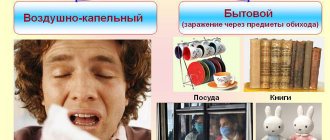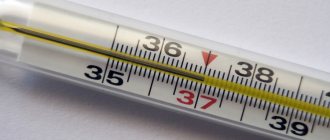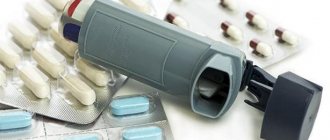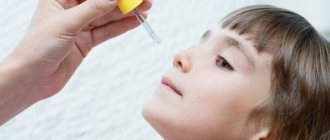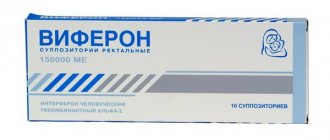How to treat allergic rhinitis
The cause of allergic rhinitis is inflammation of the mucous membrane of the respiratory tract caused by the action of allergens. The disease often occurs simultaneously with bronchial asthma, which has a similar development mechanism.
The number of patients suffering from allergic rhinitis, according to WHO, exceeds the number of patients suffering from bronchial asthma and amounts to more than 400 million people.
For the treatment of allergic rhinitis, drugs of the following main groups are prescribed:
- barrier agents;
- allergy medications - in the form of tablets, drops, solutions for inhalation: antihistamines;
- antileukotrienes;
- mast cell membrane stabilizers;
- anticholinergics;
- general action - medications taken orally (inside);
Prevention of allergic rhinitis
Against the background of allergies, the body produces a special substance - histamine. As a result, sneezing occurs, discharge from the nasal cavity, and swelling of the mucous membrane occurs. The task of antihistamines is to suppress the increased production of this substance. They are produced in different forms - tablets, drops, sprays.
For adults, the spray option is preferable due to the possibility of volumetric irrigation of the nasal cavity. They also have a dispenser to prevent overuse.
There are a lot of options for antihistamine sprays at the pharmacy. The most common and popular are the following types:
- Allergodil. Prescribed as short-term and long-term therapy for vasomotor and allergic rhinitis. Allowed for use by children from 6 years old. The annotation states that it can be taken for 6 months. The duration of treatment is determined by the attending physician.
- Levocabastine. A good, fast-acting antihistamine in spray form. The effect (relieving swelling, restoring nasal breathing) occurs 5 minutes after irrigation.
- Cromohexal. An over-the-counter drug that has an antiallergic effect. The advantage is that after achieving a therapeutic effect, use only in direct contact with the allergen.
- Fenistil. A medicine for allergic rhinitis, belonging to the group of antihistamines, antiallergic drugs. After use, a slight sedative effect is possible (increased drowsiness). One of the few remedies approved for pregnant women, starting from the second trimester (under the supervision of a doctor), and for infants from 1 month.
- Zyrtec. Reduces the severity of the allergic component and the intensity of nasal discharge. Prohibited during pregnancy, breastfeeding, and children under 6 years of age.
Pharmacological companies are constantly improving antihistamines and eliminating unwanted side effects of previous versions. 1st generation tablets for allergic rhinitis have a pronounced sedative effect, which limits their use to people whose work requires increased concentration.
- Suprastin. A proven classic 1st generation drug that relieves allergic reactions. Available in tablet form. If it is necessary to achieve a quick effect, solutions for injection are used. Allowed for children over 1 month old.
- Tavegil. Just like Suprastin, it is a first-generation medicine, but with a less pronounced sedative side effect. Children over 6 years of age are prescribed in tablet form. For children over one year old, there is a release form in the form of syrup and injection solution.
- Loratadine. Refers to second generation drugs with a minimal list of side effects. The maximum effect occurs 8 hours after administration and persists throughout the day. The dosage is calculated taking into account age and weight. Presented both in the form of tablets and syrup for children over 2 years of age.
- Cetirizine. A common new generation drug with a long period of effectiveness (24 hours after a single dose). There is no unwanted addictive effect. The dosage is determined by age. Release forms take into account different age groups: tablets for children over 6 years old, drops - from 6 months to 6 years; syrup – from 2 years.
- Telfast. Third generation antihistamine, allowed only after 12 years of age.
If signs of the disease appear, you should seek specialized help. Self-prescription is dangerous due to deterioration of the condition.
Representatives of this group are Oxymetazoline, Xylometazoline, Naphazoline, Phenylephrine. The mechanism of action is contained in their name. There is no direct effect on histamine, inflammation is not reduced, and the allergen is not neutralized. Their task is to quickly restore nasal breathing.
To purchase them in pharmacies, a prescription is not required, which leads to uncontrolled, systematic, and incorrect independent use.
Getting used to them develops very quickly, so the maximum duration of use should not exceed 3 days. Their use can provoke the development of drug-induced rhinitis. They are also characterized by a pronounced “withdrawal syndrome,” manifested by severe swelling of the mucous membrane upon refusal of vasoconstrictor drops. This is most often observed in children. To prevent such an undesirable effect, you must strictly adhere to the prescribed dosage.
For young children, a combined version has been developed - Vibrocil, which, on the one hand, has a moderate vasoconstrictor effect, and on the other, reduces the inflammatory and allergic component.
Prolonged contact with the allergen leads to the formation of circulating immune complexes. The higher their concentration, the more pronounced the clinical manifestations.
The task of enterosorbents is to remove pathological immune complexes from the body as much as possible. According to their mechanism of action, they indiscriminately neutralize all toxic compounds.
Today the most popular types of sorbents are: Enterosgel, Smecta, Multisorb.
In the treatment of allergic rhinitis, medications are used in a wide variety of formulations - from tablets and syrups to drops and sprays. In this case, the most important thing is not what a particular medicine looks like, but what generation of drugs it belongs to.
First generation
The most famous and still used first-generation remedies for the common cold are suprastin and diphenhydramine. There is no need to dwell on them in detail - and if allergic rhinitis is detected, it is still better to purchase tablets that are more highly specialized and do not depress the nervous system.
Second generation
Second-generation antihistamines for allergic rhinitis are characterized by a prolonged effect and fewer side effects. The most popular among them are:
- Citrine (based on the metabolite hydroxyzine/cyterizine). The duration of action is 24 hours, starting from the 1st hour after administration.
- Kestin (based on ebastine). The reaction to the drug is individual, the effect is sedative.
- Zyrtec is sometimes mistakenly classified as a next-generation drug (active ingredients are cyterizine and dehydrochloride). The onset of action is 15-30 minutes after administration, the duration of action is 24 hours.
- Astemisan (based on astemizole). The drug has practically no “side effects”, but it is still not recommended for children under 2 years of age and pregnant women.
We suggest you familiarize yourself with how an allergic reaction to medications manifests itself.
For children with allergic rhinitis, 2nd generation drugs are prescribed according to the following principle:
- from antihistamines - Telfast, Allergodil, Zyrtec;
- from local hormonal ones - Beclomethasone, Dexamethasone, Budesonide;
- moisturizing mucous membranes - Marimer, Salin, Aquamaris;
- from vascular-constricting sprays and drops - Nazivin, Nazol, Sanorin.
Third generation - metabolites
The main difference between these drugs and their predecessors is their high efficiency, prolonged action (up to 48 hours), no need to be tied to meals, long-term use and the absence of side effects: a depressant effect on the central nervous system, sedation and cardiotoxicity.
Medicines for allergic rhinitis of the latest generation can be given even to children under 2 years of age (in the form of syrup), and can also be used to treat diseases concomitant and similar to rhinitis that are of an allergic nature - contact dermatitis, conjunctivitis, atopic dermatitis, chronic urticaria, etc.
The list of 3rd generation drugs is as follows:
- acelastine (eye drops and nasal spray for allergic rhinitis);
- astemizole;
- fexofenadine;
- levocabastine;
- terfenadine;
- ebastine;
- acrivastine;
- loratadine and cetirizine (3rd generation tablets for allergic rhinitis);
- erius (expensive, but universal remedy).
How to choose medications for allergic rhinitis depending on individual characteristics:
- children from 1 to 4 - Loratadine, Cetirizine (in syrup), Astemizole;
- children from 4 to 12 years old - Claritin, Cetrin, Zirtek, Fenistil;
- pregnant women - Loratadine, Fexofenadine;
- for nursing mothers - Tavegil (Clemastil);
- for liver problems - Cetirizine, Loratadine, Fexofenadine;
- for kidney problems - Astemizole, Loratadine, Terfenadine.
During an allergic reaction, receptors produce the neurotransmitter histamine, which leads to the characteristic symptoms of the disease. To relieve this substance, antihistamines were developed back in the 40s of the last century. They inhibit the production of histamine, which facilitates or minimizes allergy attacks.
Unlike mast cell membrane stabilizers, antiallergic drugs should be taken after the onset of the next attack; they are not suitable for preventing the disease. In pharmacology, antihistamines are obtained synthetically or through bacterial breakdown of organic amino acids.
Since 1937, allergy medications have undergone a number of changes; today they have become more effective and have fewer side effects.
Allergies cannot be completely eliminated, so to reduce the frequency and severity of attacks, it is important to take preventive measures. They are aimed at generally strengthening the immune system and reducing the risk of direct contact with an irritant.
Rules for the prevention of hay fever:
- regularly ventilate the room, use humidifiers and air purifiers;
- reduce contact with pets and indoor flowers;
- wash bed linen and clean home textiles as often as possible;
- wear sunglasses and a hat when going outside during the flowering season;
- strengthen the immune system, harden yourself and take vitamin supplements;
- promptly treat respiratory diseases;
- Avoid overdose of medications.
Otrivin for rhinitis
Barrier allergy medications
The task of barrier remedies for allergic rhinitis is to isolate the nasal mucosa as much as possible from volatile allergens. Barrier sprays are used at the first sign of an allergy.
You need to catch the moment when sneezing attacks begin, tears flow from your eyes, and watery discharge appears from your nose.
Before introducing barrier agents, you should rinse your nose with an isotonic saline solution, for example, saline, Aqualor.
The most well-known barrier remedies for allergic rhinitis with different mechanisms of action are Nazaval, Nazaval plus, Aquamaris Sens, Prevalin and Prevalin Kids.
To create a barrier, finely divided cellulose is used in powder sprays Nazaval, Nazaval plus.
Prevalin, Prevalin Kids - gel-like sprays containing essential oils and glycerin. They create a film on the surface of the mucous membrane that protects it from contact with allergens.
To maintain the effect of Prevalin, it must be sprayed into the nose every 4 hours. The product smells pleasant and does not cause irritation to the mucous membranes. The spray can be used during pregnancy and breastfeeding.
Other treatments
The classical medicinal approach affects to a greater extent the consequences of contact between the body and an external allergen. A preventive measure is effective.
Eliminating the allergen
The best remedy for allergic rhinitis is complete elimination of the allergic component from the environment. But there are not always objective opportunities to fulfill this condition.
Therefore, medications that perform a barrier function, that is, minimize human contact with aeroallergens, are becoming popular. They are important in case of individual intolerance to drugs of the basic group, pregnancy and lactation, and active physical activity.
One of these drugs is Nazaval, which forms a durable layer in the nasal cavity. Safe for all age groups, allowed during pregnancy, as it is not absorbed into the blood. There is no conflict with other pharmacological groups.
Nasal rinsing
To achieve the maximum therapeutic effect from intranasal sprays, preliminary sanitation of the nasal cavity using saline solutions or sea water is recommended. They reduce inflammation, improve nasal breathing, and remove inhaled allergens and mucus produced.
The mucous membrane of the nasal cavity becomes moist, which is especially important after using vasoconstrictor drugs.
There are no age restrictions, allowed from early childhood.
Cleanliness in the house
The body, in which immunocomplexes constantly circulate, becomes sensitive to all allergens around it.
Allergy medications
Treatment of a runny nose, like other types of allergies, is symptomatic. Modern medicine cannot cure allergic rhinitis, but it can:
- identify allergens that cause a reaction in the immune system;
- prevent exacerbations using preventive measures;
- reduce the manifestations of the disease if it was not possible to prevent its development.
Antihistamine drops
New generation antihistamines are widely used for the treatment of allergic rhinitis, the best of which are:
- with levocabastine - Tizin Allergy, Histimet, Levocabastine;
- with azelastine - Allergodil;
Antihistamine drops are used in long-term therapy, but not more than six months. The best antihistamine drops for long-term treatment of allergic rhinitis in adults and adolescents over 12 years of age is the drug Allergodil.
It is also produced in the form of eye drops, which are used for allergic conjunctivitis, which often accompanies allergic rhinitis.
Antihistamine nasal drops containing dimethindene have proven themselves to be effective in the treatment of rhinitis:
- Finistil;
- Claritin;
- Zyrtec;
- combined agents: Vibrocil;
- Sanorin-Allergin.
A good effect, a rapid decrease in nasal congestion, is observed when using the combined drug Vibrocil. The drug is approved for children under 1 year of age, but prohibited during pregnancy and atrophic rhinitis, which is accompanied by severe dryness and nosebleeds.
Membrane stabilizers
The group includes cromoglycic acid and its salts. The role of cromoglycates is to stabilize the condition of mast cells and prevent the release of histamine from them, which triggers an allergic reaction.
Cromoglycates prevent the release of histamine not only under the influence of specific antigens, but also such nonspecific agents that trigger the release of histamine, such as:
- cold – for cold allergies;
- physical effort;
- nitrogen oxides.
For allergies, drops with cromoglycic acid, a membrane stabilizer, are used:
- Lecrolin;
- Cromohexal.
Cromoglycic acid and its analogues work well in the initial stages of a runny nose. If the exacerbation has been going on for several days, then the use of drops will be ineffective.
The same property is noted in relation to inhalations with a solution of Sodium cromoglycate through a nebulizer.
Cromoglycates in the form of sprays and inhalations are effective for allergic rhinitis combined with bronchial asthma. Medicines are inhaled from 3 to 6 times a day, depending on the instructions in the instructions for use, the best aerosols for allergic rhinitis and asthma:
- Intal;
- Intal plus;
- Intal "spinhaler" - powder aerosol;
- Lomuzol.
For the treatment of rhinitis occurring against the background of food allergies, Nalkrom capsules are a good remedy for rhinorrhea.
Powder from the Nalkrom capsule can be used for inhalation in children over 5 years of age using a spinhaler inhaler, but not exceeding the dosage specified in the instructions.
Anticholinergics
The best remedy from the group of anticholinergic drugs is Atrovent, containing ipratropium bromide. Aerosol Atrovent is used when allergic rhinitis becomes year-round.
This bronchodilator is effective for a runny nose combined with asthma; the medicine is also approved for patients with cardiovascular diseases.
Atrovent aerosol is used for treatment in pregnant women from the 2nd trimester, in children - from 6 years. Atrovent solutions for inhalation are allowed for children under 6 years of age, but always under the supervision of a doctor.
Tablets for runny nose and allergies
When treating allergic rhinitis, drugs in tablets of three generations are used:
- Suprastin, Diazolin, Tavegil;
- Cetrin, Claritin, Loratadine, Rupafin;
- Zyrtec, Telfrast, Parlazin, Nixar.
A good result is shown by the use of Nixar tablets containing bilastine for the treatment of allergic rhinitis. One Nixar tablet per day is enough to ensure the absence of rhinorrhea, swelling, lacrimation and other symptoms of allergic rhinitis for a day.
Claritin is predominantly prescribed to young children, as it is best tolerated by children, has been well studied and causes the fewest side effects.
First generation drugs, such as Suprastin Diazolin, act quickly. But they cause drowsiness, which makes them difficult to use for working adults, schoolchildren, and students.
For this group of people, it is useful to use antihistamines of the 2nd and 3rd generations to treat allergies, which do not cause drowsiness and maintain concentration. When using new generation drugs, such as Loratadine, Cetrin, taking a tablet per day is sufficient.
Children with allergic rhinitis can be treated with Erius, Zodak, Cetrin, Parlazin syrup. Medicines begin to act on average 20 minutes after use.
Hormonal remedies for runny nose
You can cope with an allergic runny nose if you suppress the allergic sensitization (mood) of the body. In case of severe exacerbation, hormonal inhaled or intranasal drugs are prescribed, which immediately stop the attack and do not have a systemic effect on the body.
Hormonal agents for topical use serve as first aid. They are prescribed in a short course, according to a specific scheme, which must be strictly followed.
Hormonal drops
The products begin to act after 6 - 12 hours, and eliminate nasal congestion for 12 - 18 hours. Drops have:
- anti-inflammatory;
- decongestant;
- antiallergic effect.
The components of the drops practically do not penetrate into the general circulatory system and do not cause any systemic side effects. The list of medications for allergic rhinitis includes hormonal drugs:
- with beclomethasone - Beconase, Rinoklenil, Nasobek, Aldecin;
- fluticasone – Avamis, Flixonase, Nazarel, Flixotide;
- mometasone – Nasonex, Desrinit, Momat rino Advance;
- budesonide - Tafen.
Inhaled glucocorticosteroids
For allergic rhinitis and attacks of bronchial asthma, inhaled hormonal drugs are prescribed. Starting from childhood, as an emergency aid, in the dosage prescribed by the attending physician, the following is used:
- beclomethasone - Becotide;
- budesonide – Pulmicort, Rhinocort;
- mometasone – Nasobek;
- fluticasone – Flixonase, Flixotide.
Hormones are inhaled through a nebulizer using a special nozzle designed for treating the nasal cavity. In this case, hormonal agents reach exclusively the nasal mucosa and are not deposited in the bronchi.
If the cause of allergic rhinitis is seasonal changes, then anti-inflammatory prophylaxis begins approximately 3 to 4 weeks before the expected exacerbation.
Blockade with Diprospan
To prevent exacerbation of allergic rhinitis, 2–3 weeks before the plant that causes the allergy begins to flower, the patient is given an intramuscular injection of Diprospan.
Diprospan blockade has an anti-inflammatory, anti-allergic effect. The medicine allows the patient to survive without the appearance of a runny nose and other allergy symptoms for a month.
Diprospan is a glucocorticoid hormone betamethasone, which can be used once every 3-4 weeks. The drug is addictive if the instructions for use are not followed; you should not use it on your own.
When Diprospan is abused, systemic side effects develop, most affecting the digestive tract, bones and nervous system.
Antileukotriene drugs
Leukotriene receptors are membrane proteins that trigger allergies under the influence of antigens. If leukotriene receptors are blocked, then hypertension will not be able to cause an allergic response.
Drugs that suppress the assembly of leukotriene molecules or block their activity:
- with montelukast - Singulair, Montelar;
- zafirlukast – the drug Acolat.
Medicines are used primarily in the treatment of asthma, as well as chronic allergic rhinitis in adults and children, taking into account age-related contraindications.
For children from 2 years of age, chewable tablets Almont, Monler, Singlon can be used in the treatment of allergic rhinitis and to prevent bronchospasm.
Treatment with folk remedies
As an additional remedy in the treatment of allergic rhinitis, traditional medicine suggests using the following recipes:
- Dilute 1 g of mumiyo in 1 liter of water, which should result in a dark-colored liquid. Take 100 ml with warm milk on an empty stomach. The course of treatment is 20 days, in spring and autumn;
- Chew zabrus (lids from honeycombs). Zabrus is a mixture of wax with a small amount of honey and has high bactericidal and immunostimulating properties. If there is no allergy to bee products, there are practically no restrictions on the use of the fence;
- Take birch tar with 0.5 tbsp. milk. Start with one drop and increase to 12, then reduce. The course of treatment is 24 days. The action of tar is based on its ability to cleanse the blood and blood vessels;
- Take blackcurrant in any form - jam, juice, fruit drinks, fresh berries;
- Take 0.5 tsp of fresh celery juice. three times a day until symptoms disappear;
- Place 5 drops of fresh aloe juice or sea buckthorn oil into your nose several times a day.
It is difficult, and sometimes impossible, to completely eliminate contact with aeroallergens suspended in the air if the patient is allergic to house dust and pollen. If elimination measures do not reduce the signs of a runny nose, drug therapy is prescribed.
Medicines have different effects on the symptoms of allergic rhinitis, since the disease can occur in both mild, moderate and severe forms, acute and chronic, seasonal and year-round. The presence of concomitant diseases is also additionally taken into account - bronchial asthma, allergic conjunctivitis. All allergy sprays are divided into three groups:
- Medicines to control the disease.
- Symptomatic drops.
- Barrier means.
There are two main routes of drug administration for allergic rhinitis - intranasal and oral. Intranasal administration of the drug - administration into the nose. To do this, use allergy drops or sprays. Oral administration - through the mouth, by swallowing. Intranasal drug administration has both comparative advantages and disadvantages (see Table 1). Table 1
| Advantages | Flaws |
|
|
How to treat exacerbations of allergic rhinitis
If preventive measures, ASIT, diet, blockade with Diprospan, still do not produce results, and an exacerbation develops, then, of course, you need to immediately go to the doctor.
But a patient who has encountered this disease more than once can take some measures on his own.
How to treat mild allergic rhinitis in adults:
- 1 rub./day Loratadine or Suprastin tablet or antihistamine nasal drops;
- Nazivin in the morning/before bed for 5 days.
Description of the disease
Allergic rhinitis occurs upon contact with an irritant.
Provoking factors may include:
- plant pollen;
- medications;
- animal hair;
- cosmetics;
- household chemicals;
- dust;
- insects.
There are 3 forms of allergic rhinitis:
- Seasonal. It usually develops in spring or summer. The seasonal form is characterized by the presence of individual intolerance to plant pollen.
- Persistent (year-round). Occurs upon contact with other pathogens (food, medicines, etc.).
- Professional. This form occurs with constant contact with an irritant, due to the characteristics of a person’s specialization. In particular, bakers often develop an allergy to flour, and carpenters often develop an allergy to formaldehyde.
Each of the listed forms of the disease is characterized by the same symptoms, the intensity of which varies depending on the degree of sensitivity of the body to a particular pathogen.
How often can you inject Diprspan if you have allergies? Read the link.
Allergic rhinitis (rhinitis), or hay fever, is a common disease that develops when the body is hypersensitive to certain irritants. With direct contact with them, a wide range of symptoms appears - itching, sneezing, profuse nasal discharge, decreased sense of smell and conjunctivitis.
Depending on the course of the disease, seasonal and year-round rhinitis are distinguished. Allergies have been confirmed in both children and adults; most often, the pathology develops between the ages of 10 and 20 years. There is no effective treatment; therapy is only symptomatic and supportive.
Antigen-specific immunotherapy (ASIT)
With an exacerbation of allergies in the blood, there is a sharp increase in the concentration of specific immunoglobulin IgE. To avoid such an increase, the patient is given small doses of the allergen outside the period of exacerbation.
This makes it possible to reduce the body's reaction to contact with the antigen. AG is administered once a week for a long time. ASIT can last up to 5 years.
The method has worked well in children. Contraindications for its use are bronchial asthma and heart disease.
Tablets for allergic rhinitis
Allergic rhinitis is an allergic inflammation of the nasal mucosa
All tablets for the common cold of allergic origin can be divided into drugs of the old and new generation. They act equally effectively, quickly and efficiently remove allergy manifestations, but old drugs have quite pronounced side effects - drowsiness, lethargy, problems with attention and concentration, possible headaches.
When taking most of these remedies, an allergic runny nose goes away very quickly, but the instructions contain a number of prohibitions for people using them, for example, driving a vehicle or working with complex instruments and mechanisms. The new generation of drugs is mostly devoid of the annoying shortcomings of the previous series. They do not cause fatigue or drowsiness, they act very quickly and effectively.
All these medications require strict adherence to the instructions for use and have strict restrictions on age and period of use.
Old but effective drugs include:
- Diazolin
- Suprastin
- Tavegil
New drugs:
- Loratadine
- Clarotadine
- Claritin
- Tsetrin
- Eden
More information on how to treat a runny nose can be found in the video:
Nasal rinsing solution: recipes and rules
Taking any medications for a runny nose or other diseases is always a big risk, which may turn out to be unjustified if you treat yourself and treat a sick child without special education. Entrust your treatment to professionals, then you can avoid complications and extremely unpleasant consequences that can significantly worsen the patient’s health.
It is especially important not to take risks if a runny nose begins during pregnancy or a small child becomes ill. In order not to expose the health of the child or fetus to significant risk, do not try to use various patented or home-grown remedies on your own. The doctor will do this much more competently, choose the most suitable drug that cannot cause harm, will only benefit, and will help you recover quickly.
Auxiliary products for allergic rhinitis
For allergies, taking enterosorbents Polysorb, Entenrosgel, Polyphepan, Smecta has a positive effect on the body. The drugs absorb and remove pathogenic intestinal microflora and remove allergens.
You cannot take the medication for a long time. Treatment with enterosorbents should not last longer than 2 weeks at the dosage specified in the instructions for use.
Vasoconstrictor drops
Auxiliary agents that are often used in the treatment of rhinitis are vasoconstrictor nasal drops. They are prescribed to reduce swelling and get rid of nasal congestion for several hours.
Preferably long-acting drugs containing xymetazoline or oxymetazoline are used, lasting 12 hours.
The list of vasoconstrictors effective for allergic rhinitis includes the following drugs:
- Nazivin;
- Xymelin;
- Otrivin;
- Tizin-Xylo;
- Snoop;
- Nazol;
- Oxymetazoline.
They should be taken in courses lasting no more than 5 days. With frequent use of drops, the formation of drug-induced rhinitis is possible, in which, without instillation of medication, the vessels are not able to narrow on their own.
Children from 2 months are allowed to take Nazol-Baby drops with phenylephrine, and from 2 years - Nazol-Kids.
What drugs to use
In the process of development of immunology, antihistamines have greatly improved. Today, all such medications for the treatment of allergic rhinitis are usually divided into two groups:
- First generation . They have a limited effect on histamine receptors, duration is limited to 4-12 hours. They have many side effects, causing drowsiness, dry mouth, and tachycardia. Examples of drugs: Diphenhydramine, Chloropyramine, Mebhydrolin.
- Second generation . Developed on the basis of 1st generation antihistamines, they have a long-lasting effect of up to 48 hours, and reliably stop the synthesis of mediators. Cause fewer side effects, but often affect heart function. Known agents: Ebastine, Cetirizine, Loratadine.
Today, most allergy medications are active metabolites of second-generation antihistamines. They extremely rarely lead to side effects, the result occurs 25-60 minutes after administration and lasts up to 24 hours. These are the tablets that are recommended for use for allergic rhinitis.
Read how to take Loratadine for adults with allergies here.
The development of Loratadine is considered a breakthrough in the treatment of allergies. This drug acts selectively on histamine receptors and is not addictive. It can also be used by children from 2 years old.
On the packaging you can often find the name H1 and H2 histamine receptors. This name is associated with their location in the human body, as a result of which such centers have different functions. To treat allergic rhinitis, it is important to buy drugs that act exclusively on H1 receptors.
Antihistamine tablets for allergies
There is a wide range of medications for allergic rhinitis in tablet form. Oral medications act quickly and effectively, unlike sprays and drops, they directly affect the mechanism of attack development. They often have similar composition and application features, since not many effective antihistamines have been developed. Popular drugs:
Cetirizine
Active blocker of H1-histamine receptors. Prevents and alleviates pathological reactions in the body, often used for hay fever and allergies to cold. The action begins within 20 minutes and can last up to 3 days. It is quickly absorbed by the body and does not accumulate in the kidneys. Cetirizine is suitable for children over 6 years old, the recommended dosage is 1 tablet per day. Contraindicated in any trimester of pregnancy. Cost – from 65 rubles
Tsetrin
A 2nd generation antihistamine based on cetirizine, does not have a sedative effect. It is used for both early and late stages of an allergic reaction. It begins to act 50-60 minutes after administration, the effect lasts up to 12 hours. Can be used for children over 6 years of age, with caution during pregnancy. Cetrin is prescribed at the rate of 1 tablet/day. Price – from 243 rub.
Loratadine
The product is used for seasonal and year-round hay fever. Has antiallergic and antipruritic effects. May cause drowsiness, tachycardia and headache. Can be used from 2 years of age, dosage – 10 mg/day for adults, 5 mg/day for children. Cost – from 35 rubles.
Semprex (Acrivastin)
An antihistamine for systemic use, it is a 2nd generation histamine blocker. It has a quick effect and is well absorbed by the body, the effect lasts up to 14 hours. May cause dizziness, drowsiness and nervousness. For children over 12 years of age, the dosage is 8 mg/day, for adults – up to 15 mg/day. Rarely found on sale, cost - 1350 rubles.

